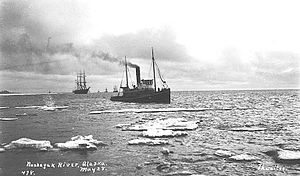Richard Holyoke (steam tug)

Richard Holyoke on the Nushagaak River.
|
|
| History | |
|---|---|
| Name: | Richard Holyoke |
| Route: | Puget Sound, San Francisco Bay, Alaska, Columbia Bar |
| Completed: | 1877, Seabeck, WA |
| Fate: | Dismantled, 1940. |
| General characteristics | |
| Class and type: | steam tug |
| Length: | 115 ft (35.1 m) |
| Installed power: | Steam engine |
| Propulsion: | Propeller |
Richard Holyoke was a seagoing steam tug boat built in 1877 in Seattle, Washington and which was in service on Puget Sound and other areas of the northwest Pacific coast until 1935. The vessel was considered to be one of the most powerful tugs of its time.
Richard Holyoke was among the first seagoing tugs to be built on Puget Sound. The vessel was constructed by shipbuilders Hiram Doncaster and William McCurdy at Seabeck, Washington and was named after the manager of the Seabeck lumber mill. In 1891, Holyoke was owned by the Washington Mill Co., which joined with four other mills to form their own tug and towing company, called the Puget Sound Tug Boat Company. Each mill contributed one tug to the new company, and the Holyoke was the contribution of Washington Mill co.
Holyoke, as the vessel was generally known, participated in numerous towing and salvage operations over the years. Some the more notable are described in this article.
In early February 1896, Richard Holyoke was dispatched to Point Wilson, where the iron-hulled British sailing ship Kilbrannan had grounded. Despite the efforts of Holyoke and four other powerful seagoing tugs, Kilbrannan could not be pulled off the beach. Kilbrannan was not a total loss, as eventually a special channel was dredged and the vessel was floated free.
On July 30, 1897, in the company of the then very old side-wheeler Eliza Anderson, the Richard Holyoke began towing several vessels from Seattle to St. Michael, Alaska to participate in the Klondike Gold Rush of 1898. The tows included the sternwheeler W.K. Merwin, the former Russian sidewheel gunboat Politkofsky stripped and converted to a fuel barge, and the small schooner William J. Bryant. After a number of misadventures, including the near-loss of the Merwin when the towing cable parted in a storm, the flotilla was eventually able to reach Nome, where the Politkovsky ended up abandoned on the beach. Both Richard Holyoke and William J. Bryant were able to make it back to Puget Sound, where the Bryant was later converted into the steamer Dode.
...
Wikipedia
